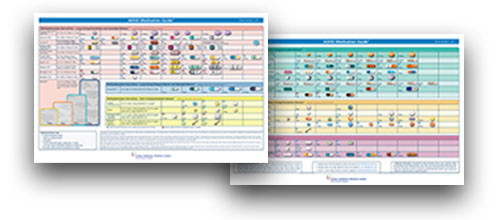
Other studies have observed higher rates of stimulant misuse among those aged 18 to 25, college students, and polydrug users. Even for ADHD medications that are considered to have lower abuse potential, information about their use outside of medical supervision or in doses exceeding a treatment regimen would constitute problematic use due to potential side effects or drug interactions. Further, NSDUH captures information on only a small subset of stimulant medications used to treat ADHD and excludes the newer classes of nonstimulant ADHD medications. However, limiting measurement of past-year NMU of ADHD drugs to persons who exclusively misused these medications likely underestimated the true population prevalence, as it would have excluded persons who were nonmedical users (NMUs) of both ADHD stimulants and other stimulants in the past year. This suggests that information about NMU of prescription stimulants may not be applicable to NMU of ADHD-specific medications.

The demographic correlates also differed between stimulants in general and ADHD stimulants. Based on these data, the past-year prevalence of NMU of only ADHD stimulants was higher among young adults aged 18 to 25 (1.3%) than among persons aged 12 to 17 (0.9%) or persons aged 26 or older (0.1%). Therefore, measurement of past-year NMU of ADHD stimulants in the study was limited to persons who had never used any other types of stimulant nonmedically.

Except for methamphetamine, however, the 2002 NSDUH asked about NMU of specific stimulants only for the lifetime period. A study that specifically identified the NMU of prescription ADHD stimulants was conducted by Kroutil and colleagues in 2006 using the 2002 National Survey on Drug Use and Health (NSDUH). Most of these investigations have grouped a variety of prescription stimulants (e.g., methamphetamine, ADHD medications, anorectic drugs) as a broad therapeutic class. What is largely known about NMU of ADHD drugs is derived from data sources that may not focus specifically on ADHD medications or from samples with limited generalizability. As the number of prescriptions increases, the availability of these medications for diversion to nonmedical use (NMU) also increases. Thus, the number of youth and adult patients receiving pharmacologic ADHD treatment is growing, and treatment includes a diverse range of stimulant and nonstimulant medications. In parallel, prescribing of medication for ADHD has increased over the past several years, particularly for adults. Patient and physician education programs also may be useful tools to heighten awareness of intentional and unintentional diversion of ADHD medications for nonmedical purposes.Ĭlinician awareness of the presence and burden of attention deficit/hyperactivity disorder (ADHD) has increased in the United States and internationally. Conclusionīecause most prescription ADHD medications currently are highly regulated, policy options for supply-side reduction of nonmedical use may include identifying those medications with lower abuse liability for inclusion on insurance formularies. Alcohol was the substance most commonly used in combination with ADHD drugs. Productivity was the most frequently endorsed reason for NMU. Among persons who had never been prescribed medication to treat ADHD, friends or family members were the most common source. Receipt of medications for ADHD was a significant correlate of past-year NMU, though most nonmedical users never had a prescription. Most respondents reporting NMU used on multiple occasions. Past-year prevalence of NMU of ADHD medications was approximately 2%, with 4.3% reported among those aged 18 to 25 and 1.3% among those aged 26 to 49. Census, and the National Survey on Drug Use and Health (NSDUH). National-level estimates were created using propensity scoring methods and weighting procedures using data from three nationally representative probability surveys: a random-digit dialed telephone survey, the current U.S. The study used a self-administered Internet survey of civilian, noninstitutionalized adults (N = 4,297) aged 18 to 49 in the United States.

Using an Internet-based epidemiological survey, this paper advances understanding of the prevalence and correlates of NMU of medications used to treat ADHD, sources of diverted medications, motivations for use, and consumption patterns. Emerging evidence suggests that nonmedical use (NMU) of prescription attention deficit/hyperactivity disorder (ADHD) medications is rising, but many previous investigations have used clinical or regionally based samples or limited their investigations to stimulants rather than to medications specifically used to treat ADHD.


 0 kommentar(er)
0 kommentar(er)
